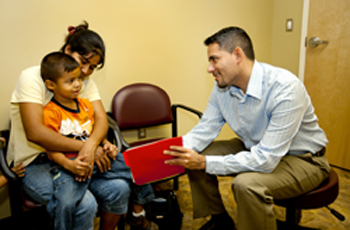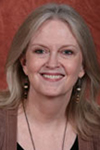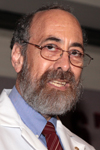
|
WHAT THEY'RE SAYING ABOUT US |
|
Excerpts from other publications
Newly renovated medical center in Immokalee ready for physicians from FSU and CHS By Liz Freeman, posted on naplesnews.com Aug. 5, 2009
IMMOKALEE — Dr. Javier Rosado spent a few cold winters in New Haven, Conn., for a predoctoral internship in clinical and community psychology at Yale University. Last September, he relocated to Immokalee for a postdoctoral fellowship with Florida State University, where he will complete 2,000 clinical hours with families, mostly children, who need therapy.
“I love it,” he says of his time so far in Immokalee. “The family system is totally different than the American family.”
On Monday, Rosado and other colleagues with FSU’s rural medicine program in Immokalee and its affiliated pediatric clinic run by Collier Health Services will occupy what used to be empty space in the FSU Isabel Collier Read Medical Center. Until now, they used other space in the building that wasn’t suitable for their purposes on a permanent basis.
The NCH Healthcare System donated the 29,000-square-foot building to FSU in December 2007 after protracted negotiations that enabled the university to bring its rural medicine training program to Immokalee for medical school students.
About $4 million has been spent to transform what had been 11,000 square feet of unused shell space in the building into a medical clinic. Half of the cost came from the Naples Children and Education Foundation, sponsors of the Naples Winter Wine Festival. Another 2,000 square feet of space will be renovated in the next stage of the project.
All told, there are 17 examination rooms for the pediatrics clinic operated by Collier Health Services, a private, nonprofit organization, in a partnership with FSU where the university provides the educational component of the program for the medical students and CHS handles the clinical operations.
“It’s been a wonderful relationship,” said Steve Weinman, chief operating officer of CHS. “I think there is a huge benefit being affiliated with a university.”
Patients are more receptive to a university affiliation but it could also be a draw to get more physicians to come to the community, even from Naples, for the experience of teaching and to acquire courtesy privileges with the university, he said.
“We are hoping to get specialists out here at some point,” said Lesa Peterson, spokeswoman for CHS.
Even an old patient transport bus was replaced with a new bus, with CHS and FSU splitting the cost, she said.
The rural medicine training program in Immokalee, which got started in January 2008, has become popular with third- and fourth-year medical students at FSU for rotations, said Dr. Karimu Smith-Barron, FSU’s faculty director for pediatrics and adolescent medicine in Immokalee.
“We usually have two to three students,” she said. “This winter between October and January, we will have 10 students. Immokalee is a hot spot. They want the experience in internal medicine.”
She even has a second-year medical student in Immokalee this summer who is going around the community assessing perceptions about health care and shadowing doctors. As a second-year medical student, it’s too early for clinical rotations for him, she said.
Today, the rural medicine program has about 10 elective options in Immokalee in terms of specialties, which include pediatrics, family medicine, women’s health, internal medicine and behavioral health.
“So there’s quite a few options,” Smith-Barron said. “And we have students coming as far as Pensacola.”
Housing has been a hindrance in attracting more students than six at a time. The students must be willing to share a room with another student in a three-bedroom, two-bath home that CHS acquired near the facility.
The hope for CHS and the Immokalee community at large is that some of the medical students would return after they complete their education to set up practices in Immokalee. The program hasn’t been operating long enough in the community for that to have happened.
But Rosado, the psychologist who began a fellowship in Immokalee last fall with FSU, said he is enjoying the experience and working with the families and the issues they face. There may be undocumented family members who face deportation, and he deals with the impact to the children or other issues that migrant children face, he said.
“It’s a very unique population,” he said. “I really enjoy the community.”
HIT and Medical Education: The Innovators Excerpt from: EHR Bloggers/ Physician insight on EHR and healthcare IT topics Friday, September 4, 2009
… [F]inding space to teach HIT in a densely packed medical school curriculum means subtracting time from something else.
The Florida
State University College of Medicine has taken a more aggressive approach.
It is one of the
newest medical
schools in the US, so its curriculum developers were not
constrained by prior commitments and teaching methods. They chose to
leapfrog ad hoc approaches to HIT education and design an Internet-age
curriculum that has medical informatics woven into its fabric.
SPEAKING OF INNOVATION… Dennis Saver , M.D., family medicine clerkship faculty in Fort Pierce, was featured prominently in a Los Angeles Times story earlier this year about the use of information technology in health care. Here’s the beginning of the article by Noam N. Levey:
The little black Toshiba, its edges worn to the bare metal, gets more use than the stethoscope and has become key to the care Saver gives his patients -- organizing medical histories, test results, prescriptions and other data that were once a jumble of paper records. Saver's laptop, and the system behind it, put him on the cutting edge of what President Obama and many experts say is a critical step to improving the nation's healthcare system while also reining in costs.
It is known as “Health IT,” an idea that promises to use information technology to cut medical errors, avoid unnecessary tests and procedures and identify better treatments. The Obama administration is betting that $19 billion of the economic stimulus package will spread the concept from coast to coast. Saver and the nine other physicians in his practice decided to take the plunge 3 1/2 years ago. Gone are tens of thousands of manila files that filled a big room in their office. Doing away with those has allowed the practice to cut its record-keeping staff from seven to three. The office eliminated 2 1/2 more positions in the billing department because clerks no longer have to struggle over doctors' handwritten notes.
In the examining room, Jim Culleton -- an 84-year old retiree who cheerfully explained that Saver had saved his life three times -- teased the doctor about his incessant tapping on the laptop. “I liked it better when he talked into his tape recorder. Now, I don't know what he's saying about me,” Culleton said. “Well, I don't lose your chart anymore,” Saver countered. “And I don't throw my back out hauling around your file.”
The laptop also allows Saver to quickly check lab results -- in Culleton's case alleviating concerns about a possible infection, something that could be deadly for the recent heart attack victim. And costly tests aren't repeated because a lab result is lost or an image is misplaced, Saver said. Thanks to warnings embedded in the electronic health record, or EHR, Saver can monitor his patients' prescriptions to avoid harmful interactions. In case of a recall, he can check the database in minutes to find out whom to notify…. |
 |
 |
 |
| E-mail Alumni Affairs Phone: 850-645-9428 | ||
|
|
|
Florida State University
|
College of Medicine
|
Copyright 2013
|
 ...
The
28-year-old psychologist says the
best part of his practice in Immokalee is learning about the cultural
differences with the mostly immigrant families and helping them.
...
The
28-year-old psychologist says the
best part of his practice in Immokalee is learning about the cultural
differences with the mostly immigrant families and helping them.
 A stethoscope with three tiny koalas dangling from his neck and eyeglasses
perched on his nose, Dennis Saver looks every bit the family doctor as he
steps into the examining room of his small practice on Florida's Treasure
Coast. When Saver begins to examine his patient, however, the 56-year-old
physician does something that four out of five doctors in America do not: He
pulls out a computer.
A stethoscope with three tiny koalas dangling from his neck and eyeglasses
perched on his nose, Dennis Saver looks every bit the family doctor as he
steps into the examining room of his small practice on Florida's Treasure
Coast. When Saver begins to examine his patient, however, the 56-year-old
physician does something that four out of five doctors in America do not: He
pulls out a computer. 